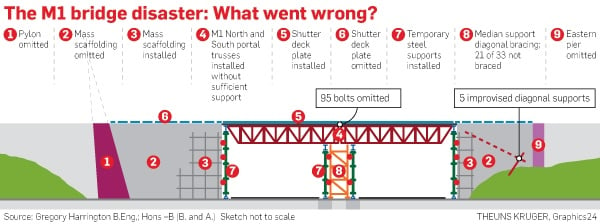
Incompetence, missing bolts and all-round negligence cited as grounds for prosecution, but no individuals have been implicated
A temporary structure for the building of a pedestrian bridge over the M1 highway was kept together by luck rather than engineering skill.
At about 3.25pm on October 14 2015, that luck ran out, as 120 tons of steel crashed on to the highway during afternoon traffic.
The collapse cost the lives of two people and injured 19, but could have been prevented, an investigation report by the department of labour shows.
The findings, especially those made against the main contractor, Murray & Roberts Construction (MRC), are damning.
The department recommends that four institutions be prosecuted, but it does not hold any individual responsible.
The report about what really led to the accident has been kept under wraps until now.
The department has refused to release the report, but the Johannesburg Development Agency (JDA), which appointed MRC, provided it to City Press’ sister publication, Rapport, on request, because it is in the public interest.
According to the report, the MRC entrusted the project to a candidate engineer, Oliver Aadnesgaard, as site engineer and to Hein Pretorius as contract manager.
Both were inexperienced and lacked the expertise for this specific project.
As a candidate engineer, Aadnesgaard should have worked under the supervision of a registered engineer, but Pretorius was not registered with the Engineering Council of SA and had no experience in building bridges or erecting temporary structures.
Contrary to the contract, MRC failed to appoint an engineer for the design of the temporary steel structure that collapsed.
In addition to designing the structure, the engineer was also meant to supervise its erection and to ensure that it was done according to design, in addition to doing regular inspections.
Instead, MRC only used the general arrangement drawings provided by the supplier of the scaffolding, Form-Scaff.
The drawings were only meant to determine the number of components needed, so that Form-Scaff could calculate the price, and was never intended to be a formal design for the erection of the temporary structure.
Read: Who’s to blame for Grayston bridge collapse?
The consequence is that MRC never worked out what load the structure would be able to carry and, therefore, whether it would be strong enough to remain standing.
In addition, MRC never planned the sequence in which the building would take place.
“It is like building a table and wanting to put up the tabletop before the legs. They erected a heavy, unstable structure across the road, without fully installing the elements Form-Scaff planned to stabilise it,” said Gregory Harrington, a structural engineer who was previously employed by MRC and who followed the case closely.
To top it all, MRC did not even follow Form-Scaff’s informal “design”. Important parts of the structure were omitted completely.
Construction of two anchor points – a pylon on the west side and a pier on the east side – had not even commenced at that point.
. At the median support, in the middle of the highway, which the entire structure effectively rested on, 21 of 33 diagonal supports had been left out.
. On both the east and the west side of the highway, reinforcements to the scaffolding were omitted.
The deviations from Form-Scaff’s sketch weakened the structure to such an extent that it could not withstand the force of the wind on the afternoon it collapsed. That is why it collapsed, the department found.
According to the report, the quality of work on the parts that were erected was poor, and various connectors were not even tightened properly.
MRC began erecting the temporary structure a few days in advance.
On October 13, the last quarter of the bridge deck plate was put in position.
During the investigation, it came to light that 95 bolts meant to keep the parts together were missing.
The company admitted that it had done no risk analysis before giving the green light for the road underneath the structure to be opened to traffic on October 14.
If a competent person had done such an inspection and an analysis, the shortcomings would have been recognised and corrected, the report found.
This could have prevented the disaster.
During the department’s investigation, Aadnesgaard did not want to say who gave the go-ahead for the road to be opened, but the report indicates that he may have been the one to do so.
At the time the contract was awarded, the JDA appointed Nemai Consulting to ensure that safety requirements at the site were met.
The department criticises Nemai’s representative, Roxana le Roux.
She recorded some of the shortcomings but failed to put a stop to the work until these were corrected.
In addition, Le Roux was not registered with the relevant regulatory body.
In the report, the department recommends the prosecution of the MRC, the JDA, Form-Scaff and Nemai Consulting for various contraventions of both construction regulations and the Occupational Health and Safety Act.
No individuals have, however, been singled out for further legal steps to be taken against them.
But Willem le Roux, attorney for the JDA and an expert in occupational safety at law firm ENSafrica, said the National Prosecuting Authority (NPA) was not bound by the decision and could prosecute any person that it believed was responsible.
However, the testimony before the department may not be used in court and the NPA will have to build the case from the start.
The listed Murray & Roberts group has since sold its construction affiliate but still retains liability for the events.
In a statement to shareholders, the group said it did not agree with various of the department’s findings, but would not elaborate on this when contacted for comment.
JDA spokesperson Susan Monyai said a presentation about the department’s report was made to the JDA board on Friday.
The board is taking legal advice as it differs with the findings regarding the JDA.
 | ||||||||||||||||||||||||||
Get in touchCity Press | ||||||||||||||||||||||||||
| ||||||||||||||||||||||||||
| Rise above the clutter | Choose your news | City Press in your inbox | ||||||||||||||||||||||||||
| City Press is an agenda-setting South African news brand that publishes across platforms. Its flagship print edition is distributed on a Sunday. |




 Publications
Publications
 Partners
Partners









